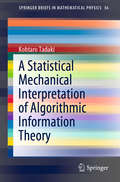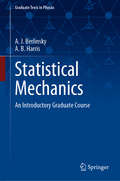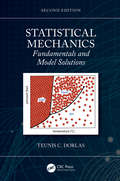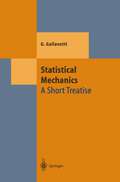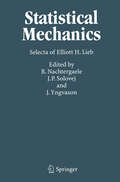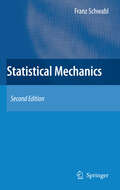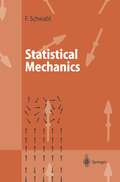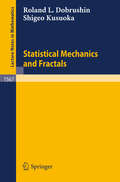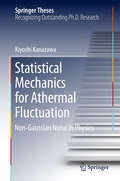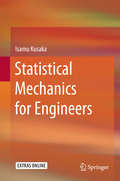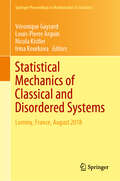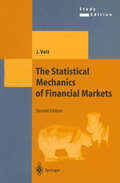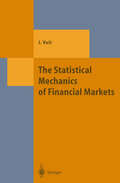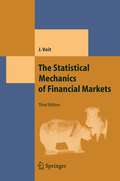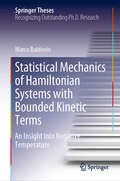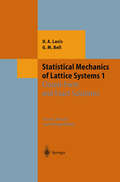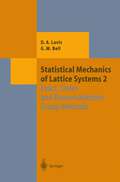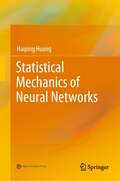- Table View
- List View
Statistical Matching: Theory and Practice (Wiley Series in Survey Methodology)
by Marcello D'Orazio Marco Di Zio Mauro ScanuThere is more statistical data produced in today’s modern society than ever before. This data is analysed and cross-referenced for innumerable reasons. However, many data sets have no shared element and are harder to combine and therefore obtain any meaningful inference from. Statistical matching allows just that; it is the art of combining information from different sources (particularly sample surveys) that contain no common unit. In response to modern influxes of data, it is an area of rapidly growing interest and complexity. Statistical Matching: Theory and Practice introduces the basics of statistical matching, before going on to offer a detailed, up-to-date overview of the methods used and an examination of their practical applications. Presents a unified framework for both theoretical and practical aspects of statistical matching. Provides a detailed description covering all the steps needed to perform statistical matching. Contains a critical overview of the available statistical matching methods. Discusses all the major issues in detail, such as the Conditional Independence Assumption and the assessment of uncertainty. Includes numerous examples and applications, enabling the reader to apply the methods in their own work. Features an appendix detailing algorithms written in the R language. Statistical Matching: Theory and Practice presents a comprehensive exploration of an increasingly important area. Ideal for researchers in national statistics institutes and applied statisticians, it will also prove to be an invaluable text for scientists and researchers from all disciplines engaged in the multivariate analysis of data collected from different sources.
Statistical Matching: A Frequentist Theory, Practical Applications, and Alternative Bayesian Approaches (Lecture Notes in Statistics #168)
by Susanne RässlerGovernment policy questions and media planning tasks may be answered by this data set. It covers a wide range of different aspects of statistical matching that in Europe typically is called data fusion. A book about statistical matching will be of interest to researchers and practitioners, starting with data collection and the production of public use micro files, data banks, and data bases. People in the areas of database marketing, public health analysis, socioeconomic modeling, and official statistics will find it useful.
A Statistical Mechanical Interpretation of Algorithmic Information Theory (SpringerBriefs in Mathematical Physics #36)
by Kohtaro TadakiThis book is the first one that provides a solid bridge between algorithmic information theory and statistical mechanics. Algorithmic information theory (AIT) is a theory of program size and recently is also known as algorithmic randomness. AIT provides a framework for characterizing the notion of randomness for an individual object and for studying it closely and comprehensively. In this book, a statistical mechanical interpretation of AIT is introduced while explaining the basic notions and results of AIT to the reader who has an acquaintance with an elementary theory of computation.A simplification of the setting of AIT is the noiseless source coding in information theory. First, in the book, a statistical mechanical interpretation of the noiseless source coding scheme is introduced. It can be seen that the notions in statistical mechanics such as entropy, temperature, and thermal equilibrium are translated into the context of noiseless source coding in a natural manner. Then, the framework of AIT is introduced. On this basis, the introduction of a statistical mechanical interpretation of AIT is begun. Namely, the notion of thermodynamic quantities, such as free energy, energy, and entropy, is introduced into AIT. In the interpretation, the temperature is shown to be equal to the partial randomness of the values of all these thermodynamic quantities, where the notion of partial randomness is a stronger representation of the compression rate measured by means of program-size complexity. Additionally, it is demonstrated that this situation holds for the temperature itself as a thermodynamic quantity. That is, for each of all the thermodynamic quantities above, the computability of its value at temperature T gives a sufficient condition for T to be a fixed point on partial randomness.In this groundbreaking book, the current status of the interpretation from both mathematical and physical points of view is reported. For example, a total statistical mechanical interpretation of AIT that actualizes a perfect correspondence to normal statistical mechanics can be developed by identifying a microcanonical ensemble in the framework of AIT. As a result, the statistical mechanical meaning of the thermodynamic quantities of AIT is clarified. In the book, the close relationship of the interpretation to Landauer's principle is pointed out.
Statistical Mechanics: An Introductory Graduate Course (Graduate Texts in Physics)
by A. J. Berlinsky A. B. HarrisIn a comprehensive treatment of Statistical Mechanics from thermodynamics through the renormalization group, this book serves as the core text for a full-year graduate course in statistical mechanics at either the Masters or Ph.D. level. Each chapter contains numerous exercises, and several chapters treat special topics which can be used as the basis for student projects. The concept of scaling is introduced early and used extensively throughout the text. At the heart of the book is an extensive treatment of mean field theory, from the simplest decoupling approach, through the density matrix formalism, to self-consistent classical and quantum field theory as well as exact solutions on the Cayley tree. Proceeding beyond mean field theory, the book discusses exact mappings involving Potts models, percolation, self-avoiding walks and quenched randomness, connecting various athermal and thermal models. Computational methods such as series expansions and Monte Carlo simulations are discussed, along with exact solutions to the 1D quantum and 2D classical Ising models. The renormalization group formalism is developed, starting from real-space RG and proceeding through a detailed treatment of Wilson’s epsilon expansion. Finally the subject of Kosterlitz-Thouless systems is introduced from a historical perspective and then treated by methods due to Anderson, Kosterlitz, Thouless and Young. Altogether, this comprehensive, up-to-date, and engaging text offers an ideal package for advanced undergraduate or graduate courses or for use in self study.
Statistical Mechanics: Fundamentals and Model Solutions
by Teunis C DorlasStatistical Mechanics: Fundamentals and Model Solutions, Second Edition Fully updated throughout and with new chapters on the Mayer expansion for classical gases and on cluster expansion for lattice models, this new edition of Statistical Mechanics: Fundamentals and Model Solutions provides a comprehensive introduction to equilibrium statistical mechanics for advanced undergraduate and graduate students of mathematics and physics. The author presents a fresh approach to the subject, setting out the basic assumptions clearly and emphasizing the importance of the thermodynamic limit and the role of convexity. With problems and solutions, the book clearly explains the role of models for physical systems, and discusses and solves various models. An understanding of these models is of increasing importance as they have proved to have applications in many areas of mathematics and physics. Features Updated throughout with new content from the field An established and well-loved textbook Contains new problems and solutions for further learning opportunity Author Professor Teunis C. Dorlas is at the Dublin Institute for Advanced Studies, Ireland.
Statistical Mechanics: Fundamentals and Model Solutions
by Teunis C DorlasStatistical Mechanics: Fundamentals and Model Solutions, Second Edition Fully updated throughout and with new chapters on the Mayer expansion for classical gases and on cluster expansion for lattice models, this new edition of Statistical Mechanics: Fundamentals and Model Solutions provides a comprehensive introduction to equilibrium statistical mechanics for advanced undergraduate and graduate students of mathematics and physics. The author presents a fresh approach to the subject, setting out the basic assumptions clearly and emphasizing the importance of the thermodynamic limit and the role of convexity. With problems and solutions, the book clearly explains the role of models for physical systems, and discusses and solves various models. An understanding of these models is of increasing importance as they have proved to have applications in many areas of mathematics and physics. Features Updated throughout with new content from the field An established and well-loved textbook Contains new problems and solutions for further learning opportunity Author Professor Teunis C. Dorlas is at the Dublin Institute for Advanced Studies, Ireland.
Statistical Mechanics: A Short Treatise (Theoretical and Mathematical Physics)
by Giovanni GallavottiThis clear book presents a critical and modern analysis of the conceptual foundations of statistical mechanics as laid down in Boltzmann's works. The author emphasises the relation between microscopic reversibility and macroscopic irreversibility, explaining fundamental concepts in detail.
Statistical Mechanics: Lectures given at a Summer School of the Centro Internazionale Matematico Estivo (C.I.M.E.) held in Bressanone (Bolzano), Italy, June 21-27, 1976 (C.I.M.E. Summer Schools #71)
by Giovanni GallavottiC. Cercignani: A sketch of the theory of the Boltzmann equation.- O.E. Lanford: Qualitative and statistical theory of dissipative systems.- E.H. Lieb: many particle Coulomb systems.- B. Tirozzi: Report on renormalization group.- A. Wehrl: Basic properties of entropy in quantum mechanics.
Statistical Mechanics: Selecta of Elliott H. Lieb
by E.H. LiebIn Statistical Physics one of the ambitious goals is to derive rigorously, from statistical mechanics, the thermodynamic properties of models with realistic forces. Elliott Lieb is a mathematical physicist who meets the challenge of statistical mechanics head on, taking nothing for granted and not being content until the purported consequences have been shown, by rigorous analysis, to follow from the premises. The present volume contains a selection of his contributions to the field, in particular papers dealing with general properties of Coulomb systems, phase transitions in systems with a continuous symmetry, lattice crystals, and entropy inequalities. It also includes work on classical thermodynamics, a discipline that, despite many claims to the contrary, is logically independent of statistical mechanics and deserves a rigorous and unambiguous foundation of its own. The articles in this volume have been carefully annotated by the editors.
Statistical Mechanics (Advanced Texts in Physics)
by Franz SchwablThis completely revised edition of the classical book on Statistical Mechanics covers the basic concepts of equilibrium and non-equilibrium statistical physics. In addition to a deductive approach to equilibrium statistics and thermodynamics based on a single hypothesis this book treats the most important elements of non-equilibrium phenomena. Intermediate calculations are presented in complete detail. Problems at the end of each chapter help students to consolidate their understanding of the material. Beyond the fundamentals, this text demonstrates the breadth of the field and its great variety of applications.
Statistical Mechanics (Advanced Texts in Physics)
by Franz SchwablThis unique and consistent mathematical treatise contains a deductive description of equilibrium statistics and thermodynamics. The most important elements of non-equilibrium phenomena are also treated. In addition to the fundamentals, the text tries to show how large the area of statistical mechanics is and how many applications can be found here. Modern areas such as renormalization group theory, percolation, stochastic equations of motion and their applications in critical dynamics, as well as fundamental thoughts of irreversibility are discussed. The text will be useful for advanced students in physics and other sciences who have profound knowledge of quantum mechanics.
Statistical Mechanics and Fractals (Lecture Notes in Mathematics #1567)
by Roland L. Dobrushin Shigeo KusuokaThis book is composed of two texts, by R.L. Dobrushin and S. Kusuoka, each representing the content of a course of lectures given by the authors. They are pitched at graduate student level and are thus very accessible introductions to their respective subjects for students and non specialists. CONTENTS: R.L. Dobrushin: On the Way to the Mathematical Foundations of Statistical Mechanics.- S. Kusuoka: Diffusion Processes on Nested Fractals.
Statistical Mechanics: Entropy, Order Parameters, and Complexity (Oxford Master Series in Physics #14)
by James P. SethnaStatistical mechanics is our tool for deriving the laws that emerge from complex systems. Sethna's text distills the subject to be accessible to those in all realms of science and engineering — avoiding extensive use of quantum mechanics, thermodynamics, and molecular physics. Statistical mechanics explains how bacteria search for food, and how DNA replication is proof-read in biology; optimizes data compression, and explains transitions in complexity in computer science; explains the onset of chaos, and launched random matrix theory in mathematics; addresses extreme events in engineering; and models pandemics and language usage in the social sciences. Sethna's exercises introduce physicists to these triumphs and a hundred others — broadening the horizons of scholars both practicing and nascent. Flipped classrooms and remote learning can now rely on 33 pre-class exercises that test reading comprehension (Emergent vs. fundamental; Weirdness in high dimensions; Aging, entropy and DNA), and 70 in-class activities that illuminate and broaden knowledge (Card shuffling; Human correlations; Crackling noises). Science is awash in information, providing ready access to definitions, explanations, and pedagogy. Sethna's text focuses on the tools we use to create new laws, and on the fascinating simple behavior in complex systems that statistical mechanics explains.
Statistical Mechanics for Athermal Fluctuation: Non-Gaussian Noise in Physics (Springer Theses)
by Kiyoshi KanazawaThe author investigates athermal fluctuation from the viewpoints of statistical mechanics in this thesis. Stochastic methods are theoretically very powerful in describing fluctuation of thermodynamic quantities in small systems on the level of a single trajectory and have been recently developed on the basis of stochastic thermodynamics. This thesis proposes, for the first time, a systematic framework to describe athermal fluctuation, developing stochastic thermodynamics for non-Gaussian processes, while thermal fluctuations are mainly addressed from the viewpoint of Gaussian stochastic processes in most of the conventional studies. First, the book provides an elementary introduction to the stochastic processes and stochastic thermodynamics. The author derives a Langevin-like equation with non-Gaussian noise as a minimal stochastic model for athermal systems, and its analytical solution by developing systematic expansions is shown as the main result. Furthermore, the author shows a thermodynamic framework for such non-Gaussian fluctuations, and studies some thermodynamics phenomena, i.e. heat conduction and energy pumping, which shows distinct characteristics from conventional thermodynamics. The theory introduced in the book would be a systematic foundation to describe dynamics of athermal fluctuation quantitatively and to analyze their thermodynamic properties on the basis of stochastic methods.
Statistical Mechanics for Engineers
by Isamu KusakaThis book provides a gentle introduction to equilibrium statistical mechanics. The particular aim is to fill the needs of readers who wish to learn the subject without a solid background in classical and quantum mechanics. The approach is unique in that classical mechanical formulation takes center stage. The book will be of particular interest to advanced undergraduate and graduate students in engineering departments.
Statistical Mechanics of Classical and Disordered Systems: Luminy, France, August 2018 (Springer Proceedings in Mathematics & Statistics #293)
by Véronique Gayrard Louis-Pierre Arguin Nicola Kistler Irina KourkovaThese proceedings of the conference Advances in Statistical Mechanics, held in Marseille, France, August 2018, focus on fundamental issues of equilibrium and non-equilibrium dynamics for classical mechanical systems, as well as on open problems in statistical mechanics related to probability, mathematical physics, computer science, and biology. Statistical mechanics, as envisioned more than a century ago by Boltzmann, Maxwell and Gibbs, has recently undergone stunning twists and developments which have turned this old discipline into one of the most active areas of truly interdisciplinary and cutting-edge research. The contributions to this volume, with their rather unique blend of rigorous mathematics and applications, outline the state-of-the-art of this success story in key subject areas of equilibrium and non-equilibrium classical and quantum statistical mechanics of both disordered and non-disordered systems. Aimed at researchers in the broad field of applied modern probability theory, this book, and in particular the review articles, will also be of interest to graduate students looking for a gentle introduction to active topics of current research.
The Statistical Mechanics of Financial Markets (Theoretical and Mathematical Physics)
by Johannes VoitThis textbook describes parallels between statistical physics and finance - both those established in the 100-year-long interaction between these disciplines, as well as new research results on capital markets. The random walk, well known in physics, is also the basic model in finance, upon which are built, for example, the Black--Scholes theory of option pricing and hedging, or methods of risk control using diversification. Here the underlying assumptions are discussed using empirical financial data and analogies to physical models such as fluid flows, turbulence, or superdiffusion. On this basis, new theories of derivative pricing and risk control can be formulated. Computer simulations of interacting agent models of financial markets provide insights into the origins of asset price fluctuations. Stock exchange crashes can be modelled in ways analogous to phase transitions and earthquakes. These models allow for predictions. This study edition has been updated with a presentation of several new and significant developments, e.g. the dynamics of volatility smiles and implied volatility surfaces, path integral approaches to option pricing, a new and accurate simulation scheme for options, multifractals, the application of nonextensive statistical mechanics to financial markets, and the minority game. Moreover, the book was scanned for and corrected from errors, both typographical and in presentation.
The Statistical Mechanics of Financial Markets (Theoretical and Mathematical Physics)
by Johannes VoitA careful examination of the interaction between physics and finance. It takes a look at the 100-year-long history of co-operation between the two fields and goes on to provide new research results on capital markets - taken from the field of statistical physics. The random walk model, well known in physics, is one good example of where the two disciplines meet. In the world of finance it is the basic model upon which the Black-Scholes theory of option pricing and hedging has been built. The underlying assumptions are discussed using empirical financial data and analogies to physical models such as fluid flows, turbulence, or superdiffusion. On this basis, new theories of derivative pricing and risk control can be formulated.
The Statistical Mechanics of Financial Markets (Theoretical and Mathematical Physics)
by Johannes VoitThe present third edition of The Statistical Mechanics of Financial Markets is published only four years after the ?rst edition. The success of the book highlights the interest in a summary of the broad research activities on the application of statistical physics to ?nancial markets. I am very grateful to readers and reviewers for their positive reception and comments. Why then prepare a new edition instead of only reprinting and correcting the second edition? The new edition has been signi?cantly expanded, giving it a more pr- tical twist towards banking. The most important extensions are due to my practical experience as a risk manager in the German Savings Banks’ As- ciation (DSGV): Two new chapters on risk management and on the closely related topic of economic and regulatory capital for ?nancial institutions, - spectively, have been added. The chapter on risk management contains both the basics as well as advanced topics, e. g. coherent risk measures, which have not yet reached the statistical physics community interested in ?nancial m- kets. Similarly, it is surprising how little research by academic physicists has appeared on topics relating to Basel II. Basel II is the new capital adequacy framework which will set the standards in risk management in many co- tries for the years to come. Basel II is responsible for many job openings in banks for which physicists are extemely well quali?ed. For these reasons, an outline of Basel II takes a major part of the chapter on capital.
Statistical Mechanics of Hamiltonian Systems with Bounded Kinetic Terms: An Insight into Negative Temperature (Springer Theses)
by Marco BaldovinRecent experimental evidence about the possibility of "absolute negative temperature" states in physical systems has triggered a stimulating debate about the consistency of such a concept from the point of view of Statistical Mechanics. It is not clear whether the usual results of this field can be safely extended to negative-temperature states; some authors even propose fundamental modifications to the Statistical Mechanics formalism, starting with the very definition of entropy, in order to avoid the occurrence of negative values of the temperature tout-court.The research presented in this thesis aims to shed some light on this controversial topic. To this end, a particular class of Hamiltonian systems with bounded kinetic terms, which can assume negative temperature, is extensively studied, both analytically and numerically. Equilibrium and out-of-equilibrium properties of this kind of system are investigated, reinforcing the overall picture that the introduction of negative temperature does not lead to any contradiction or paradox.
The Statistical Mechanics of Interacting Walks, Polygons, Animals and Vesicles (Oxford Lecture Series in Mathematics and Its Applications)
by E.J. Janse van RensburgThe self-avoiding walk is a classical model in statistical mechanics, probability theory and mathematical physics. It is also a simple model of polymer entropy which is useful in modelling phase behaviour in polymers. This monograph provides an authoritative examination of interacting self-avoiding walks, presenting aspects of the thermodynamic limit, phase behaviour, scaling and critical exponents for lattice polygons, lattice animals and surfaces. It also includes a comprehensive account of constructive methods in models of adsorbing, collapsing, and pulled walks, animals and networks, and for models of walks in confined geometries. Additional topics include scaling, knotting in lattice polygons, generating function methods for directed models of walks and polygons, and an introduction to the Edwards model. This essential second edition includes recent breakthroughs in the field, as well as maintaining the older but still relevant topics. New chapters include an expanded presentation of directed models, an exploration of methods and results for the hexagonal lattice, and a chapter devoted to the Monte Carlo methods.
The Statistical Mechanics of Interacting Walks, Polygons, Animals and Vesicles (Oxford Lecture Series in Mathematics and Its Applications)
by E.J. Janse van RensburgThe self-avoiding walk is a classical model in statistical mechanics, probability theory and mathematical physics. It is also a simple model of polymer entropy which is useful in modelling phase behaviour in polymers. This monograph provides an authoritative examination of interacting self-avoiding walks, presenting aspects of the thermodynamic limit, phase behaviour, scaling and critical exponents for lattice polygons, lattice animals and surfaces. It also includes a comprehensive account of constructive methods in models of adsorbing, collapsing, and pulled walks, animals and networks, and for models of walks in confined geometries. Additional topics include scaling, knotting in lattice polygons, generating function methods for directed models of walks and polygons, and an introduction to the Edwards model. This essential second edition includes recent breakthroughs in the field, as well as maintaining the older but still relevant topics. New chapters include an expanded presentation of directed models, an exploration of methods and results for the hexagonal lattice, and a chapter devoted to the Monte Carlo methods.
Statistical Mechanics of Lattice Systems: Volume 1: Closed-Form and Exact Solutions (Theoretical and Mathematical Physics)
by David Lavis George M. BellThis two-volume work provides a comprehensive study of the statistical mechanics of lattice models. It introduces readers to the main topics and the theory of phase transitions, building on a firm mathematical and physical basis. Volume 1 contains an account of mean-field and cluster variation methods successfully used in many applications in solid-state physics and theoretical chemistry, as well as an account of exact results for the Ising and six-vertex models and those derivable by transformation methods.
Statistical Mechanics of Lattice Systems: Volume 2: Exact, Series and Renormalization Group Methods (Theoretical and Mathematical Physics)
by David Lavis George M. BellMost of the interesting and difficult problems in statistical mechanics arise when the constituent particles of the system interact with each other with pair or multipartiele energies. The types of behaviour which occur in systems because of these interactions are referred to as cooperative phenomena giving rise in many cases to phase transitions. This book and its companion volume (Lavis and Bell 1999, referred to in the text simply as Volume 1) are princi pally concerned with phase transitions in lattice systems. Due mainly to the insights gained from scaling theory and renormalization group methods, this subject has developed very rapidly over the last thirty years. ' In our choice of topics we have tried to present a good range of fundamental theory and of applications, some of which reflect our own interests. A broad division of material can be made between exact results and ap proximation methods. We have found it appropriate to inelude some of our discussion of exact results in this volume and some in Volume 1. Apart from this much of the discussion in Volume 1 is concerned with mean-field theory. Although this is known not to give reliable results elose to a critical region, it often provides a good qualitative picture for phase diagrams as a whole. For complicated systems some kind of mean-field method is often the only tractable method available. In this volume our main concern is with scaling theory, algebraic methods and the renormalization group.
Statistical Mechanics of Neural Networks
by Haiping HuangThis book highlights a comprehensive introduction to the fundamental statistical mechanics underneath the inner workings of neural networks. The book discusses in details important concepts and techniques including the cavity method, the mean-field theory, replica techniques, the Nishimori condition, variational methods, the dynamical mean-field theory, unsupervised learning, associative memory models, perceptron models, the chaos theory of recurrent neural networks, and eigen-spectrums of neural networks, walking new learners through the theories and must-have skillsets to understand and use neural networks. The book focuses on quantitative frameworks of neural network models where the underlying mechanisms can be precisely isolated by physics of mathematical beauty and theoretical predictions. It is a good reference for students, researchers, and practitioners in the area of neural networks.


